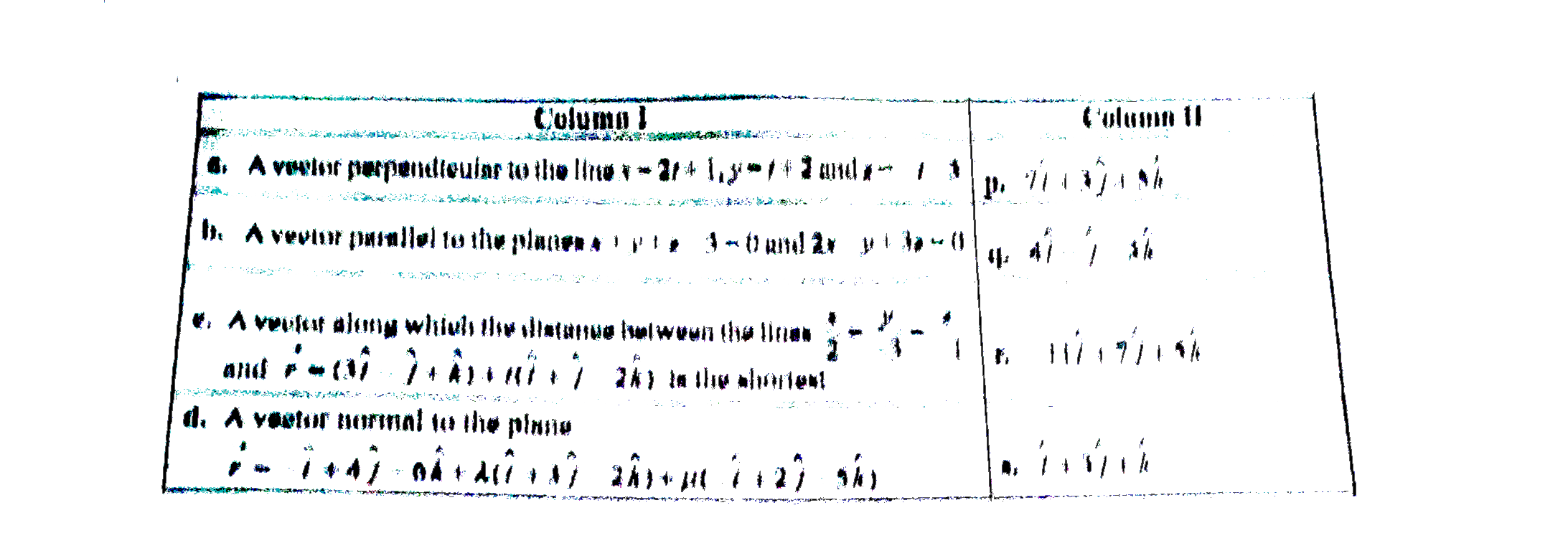Statement 1: Lines →r=ˆi+ˆj−ˆk+λ(3ˆi−ˆj)and→r=4ˆi−ˆk+μ(2ˆi+3ˆk) intersect. Statement 2: →b×→d=0 , then lines →r=→a+λ→band→r=→c+λ→d do not intersect.Solution in Bengali
Both the statements are true, and Statement 2 is the correct explanation for Statement 1.
Both the Statements are true, but Statement 2 is not the correct explanation for Statement 1.
Statement 1 is true and Statement 2 is false.
Statement 1 is false and Statement 2 is true.
The correct Answer is:b
Given lines are parallel as both are directed along the same vector (ˆi+ˆj−ˆk) , so they do not intersect.
Also Statement 2 is correct by definitioin of skew lines, by skew lines are those which are neither parallel nor intersecting. Hence, both the statements are true, but Statement 2 is not the correct explanation for Statement 1.
Topper's Solved these Questions
- THREE-DIMENSIONAL GEOMETRY Book:CENGAGE PUBLICATIONChapter:THREE-DIMENSIONAL GEOMETRY Exercise:LINKED COMPREHENSION TYPE
Explore 12 Videos
- THREE-DIMENSIONAL GEOMETRY Book:CENGAGE PUBLICATIONChapter:THREE-DIMENSIONAL GEOMETRY Exercise:MATRIX-MATCH TYPE
Explore 5 Videos
- THREE-DIMENSIONAL GEOMETRY Book:CENGAGE PUBLICATIONChapter:THREE-DIMENSIONAL GEOMETRY Exercise:MULTIPLE CORRECT ANSWER TYPE
Explore 17 Videos
- THREE DIMENSIONAL GEOMETRYBook:CENGAGE PUBLICATIONChapter:THREE DIMENSIONAL GEOMETRYExercise:All Questions
Explore 291 Videos
- TRIGONOMETRIC EQUATIONSBook:CENGAGE PUBLICATIONChapter:TRIGONOMETRIC EQUATIONSExercise:Archives (Numerical value type)
Explore 4 Videos
Similar Questions
Given four points A(2,1,0),B(1,0,1),C(3,0,1)andD(0,0,2). Point D lies on a line L orthogonal to the plane determined by the points A, B and C.
The equation of the plane ABC is
View Solution
View SolutionLet PM be the perpendicular from the point P(1,2,3) to the x−y plane. If →OP makes an angle θ with the positive direction of the z− axis and→OM makes an angle φ with the positive direction of x− axis, whereO is the origin and θandφ are acute angels, then a. cosθcosφ=1/√14 b. sinθsinφ=2/√14 c. tanφ=2 d. tanθ=√5/3
View SolutionFind the angle between the line whose direction cosines are given by l+m+n=0andl2+m2−n2=0.
View SolutionThe number of all possible values of θ, where 0<θ<π, for which the system of equations (y+z)cos3θ=(xyz)sin3θ,xsin3θ=2cos3θy+2sin3θzand(xyz)sin3θ=(y+2z)cos3θ+ysin3θ have a solution (x0,y0,z0) wiith y0z0≠0 is
View SolutionDetermine whether the following pair of lines intersect or not. (1) →r=ˆi−5ˆj+λ(2ˆi+ˆk);→r=2ˆi−ˆj+μ(ˆi+ˆj−ˆk) (2) →r=ˆi+ˆj−ˆk+λ(3ˆi−ˆj);→r=4ˆi−ˆk+μ(2ˆi+3ˆk)
View SolutionStatement 1: Lines →r=ˆi+ˆj−ˆk+λ(3ˆi−ˆj)and→r=4ˆi−ˆk+μ(2ˆi++3ˆk) intersect. Statement 2: →b×→d=0 , then lines →r=→a+λ→band→r=→c+λ→d do not intersect.
View SolutionFind →a.(→b×→c) if →a=2ˆi+ˆj+3ˆk, →b=−ˆi+2ˆj+ˆk and →c=3ˆi+ˆj+2ˆk.
View SolutionShow that the lines
→r=(ˆi−ˆj)+λ(2ˆi+ˆk) and →r=(2ˆi−ˆj)+μ(ˆi+ˆj−ˆk)
do not intersect .
View SolutionFind the shortest distance between the given line
→r=(λ−1)ˆi+(λ+1)ˆj+(λ+1)ˆk
vec(r ) =(1−μ)ˆi+(2μ−1)ˆj+(μ+2)ˆk.
View SolutionLet →a=ˆi+ˆj;→b=2ˆi−ˆk. Then vector →r satisfying →r×→a=→b×→a and →r×→b=→a×→b then →r is a.ˆi−ˆj+ˆk b. 3ˆi−ˆj+ˆk c. 3ˆi+ˆj−ˆk d. ˆi−ˆj−ˆk
View SolutionDetermine whether the following pair of lines intersect or not. (1) →r=ˆi−5ˆj+λ(2ˆi+ˆk);→r=2ˆi−ˆj+μ(ˆi+ˆj−ˆk) (2) →r=ˆi+ˆj−ˆk+λ(3ˆi−ˆj);→r=4ˆi−ˆk+μ(2ˆi+3ˆk)
View SolutionStatement 1: Lines →r=ˆi+ˆj−ˆk+λ(3ˆi−ˆj)and→r=4ˆi−ˆk+μ(2ˆi++3ˆk) intersect. Statement 2: →b×→d=0 , then lines →r=→a+λ→band→r=→c+λ→d do not intersect.
View SolutionIf →a=2ˆi−ˆj+ˆk, →b=ˆi+ˆj−2ˆk and →c=ˆi+3ˆj−ˆk, f∈d λ such that →a is perpendicular to λ vec b+→c
View SolutionIf →a=2ˆi+2ˆj+3ˆk, →b=−ˆi+2ˆj+ˆk and →c=3ˆi+ˆj are such that →a+λ→b perpendiculr to →c, then find the value of λ.
View SolutionFind →a.(→b×→c) if →a=2ˆi+ˆj+3ˆk, →b=−ˆi+2ˆj+ˆk and →c=3ˆi+ˆj+2ˆk.
View Solution